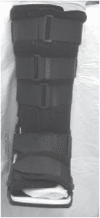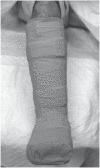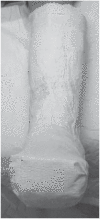Foot ulcers in the diabetic patient, prevention and treatment
- PMID: 17583176
- PMCID: PMC1994045
Foot ulcers in the diabetic patient, prevention and treatment
Abstract
Lower extremity complications in persons with diabetes have become an increasingly significant public health concern in both the developed and developing world. These complications, beginning with neuropathy and subsequent diabetic foot wounds frequently lead to infection and lower extremity amputation even in the absence of critical limb ischemia. In order to diminish the detrimental consequences associated with diabetic foot ulcers, a common-sense-based treatment approach must be implemented. Many of the etiological factors contributing to the formation of diabetic foot ulceration may be identified using simple, inexpensive equipment in a clinical setting. Prevention of diabetic foot ulcers can be accomplished in a primary care setting with a brief history and screening for loss of protective sensation via the Semmes-Weinstein monofilament. Specialist clinics may quantify neuropathy, plantar foot pressure, and assess vascular status with Doppler ultrasound and ankle-brachial blood pressure indices. These measurements, in conjunction with other findings from the history and physical examination, may enable clinicians to stratify patients based on risk and help determine the type of intervention. Other effective clinical interventions may include patient education, optimizing glycemic control, smoking cessation, and diligent foot care. Recent technological advanced combined with better understanding of the wound healing process have resulted in a myriad of advanced wound healing modalities in the treatment of diabetic foot ulcers. However, it is imperative to remember the fundamental basics in the healing of diabetic foot ulcers: adequate perfusion, debridement, infection control, and pressure mitigation. Early recognition of the etiological factors along with prompt management of diabetic foot ulcers is essential for successful outcome.
Figures









References
-
- Introduction. Healing chronic wounds: technologic solutions for today and tomorrow. Adv Skin Wound Care. 2000;13(Suppl2):4–5. - PubMed
-
- Living skin substitute can heal diabetic foot ulcer wounds. FDA Consum. 2000;34:6. - PubMed
-
- Peripheral arterial disease in people with diabetes. Diabetes Care. 2003;26:3333–41. - PubMed
-
- Incidence of end-stage renal disease among persons with diabetes—United States, 1990–2002. MMWR Morb Mortal Wkly Rep. 2005;54:1097–100. - PubMed
-
- Abbott CA, Carrington AL, et al. The North-West Diabetes Foot Care Study: incidence of, and risk factors for, new diabetic foot ulceration in a community-based patient cohort. Diabet Med. 2002;19:377–84. - PubMed
Publication types
MeSH terms
Substances
LinkOut - more resources
Full Text Sources
Other Literature Sources

